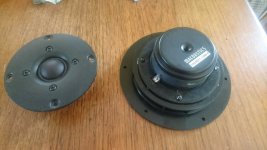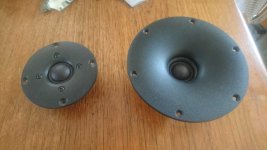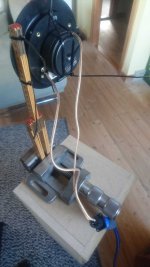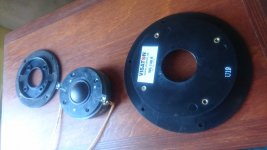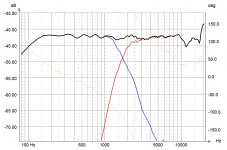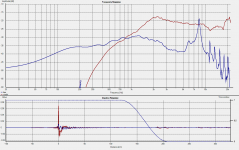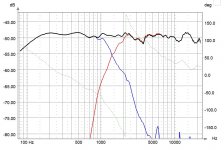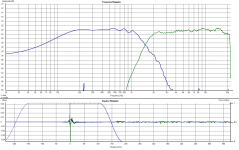Cone edge resonance. There's not a large body of empirical research on it but the standing theory (no pun intended) is that part of the surround is out-of-phase with the cone at that point, and/or the very edge of the cone is breaking up (but not the main part of the cone).Go to the off axis FR measurement, where you can see the FR become less smooth around 500hz. Just, like this hivi m5a which is a similar size metal cone that starts resonating at around same point.
https://www.parts-express.com/pedocs/specs/297-437-hi-vi-m5a-specifications-45110.pdf
The Satori midrange series is a pretty well-known example as well.
New 5" Satori MW13P
www.audioexcite.com >> SB Acoustics “Satori” MW13P-8
Cone edge resonance. There's not a large body of empirical research on it but the standing theory (no pun intended) is that part of the surround is out-of-phase with the cone at that point, and/or the very edge of the cone is breaking up (but not the main part of the cone).
The Satori midrange series is a pretty well-known example as well.
New 5" Satori MW13P
www.audioexcite.com >> SB Acoustics “Satori” MW13P-8
Sounds right to me. Its part of the zone where it transitions from pistonic to my precious break up. There is probably some flexing but the cone isn't fully out of phase with itself. Information on this is surprisingly obscure.
No... after that dip, everything is pistonic and in-phase.Its part of the zone where it transitions from pistonic to my precious break up.
Last edited:
Go to the off axis FR measurement, where you can see the FR become less smooth around 500hz.
I'm looking at it now, and I see a drive unit that in the 500Hz - 1KHz region you emphasise exhibits +/- 1dB variation in the on out to 60 degrees off axis responses, with no variation in the impedance response either, confirming the powertrain is acting as a pure piston across this BW. If it wasn't, you would see it there also.
Just, like this hivi m5a
Not at all like the M5a I think you'll find if you analyse the data. Unlike the M5a, which is clearly starting to run into issues from approximately 550Hz, which are visible in both the FR and impedance response (despite the lousy resolution), the HFC data for the SB shows it remains in piston operation, with its response curve and impedance both remaining linear out to approximately 4KHz, with minor variation as you move off-axis from about 2.6KHz due to diffraction from the roll surround (which is not cone or suspension resonance). The HiVi is a very inexpensive driver, and does not have anything like the same quality of cone, suspension, motor or basket design, and that is reflected in its inferior performance.
...afaik normal domes leave the pistonic range and have resonances long before serious break up.
Well, two points there. First, you haven't stated what you believe constitutes a 'normal dome', and second: any resonance is 'break up'. Degree of said is irrelevant: if it's resonance, that's what it is.
Honestly I post here with good intentions but you're completely trying to misconstrue this. I was referring to the shift in FR from being smooth to choppy.
Misconstrue what? What are you defining as 'smooth' and 'choppy', and what technical basis are you using to conclude said? I'm currently looking at both the Seas and HFC measurements of the W22EX001 and it is clearly in pistonic operation out to about 1.8KHz, as shown in the frequency, impedance and HD plots.
And yes it coincides with the driver response narrowing (no longer omnidirectional).
I'm seeing a fall in off-axis response through cone & surround geometry, as you would expect of a driver of its dimensions.
And yes there is still a rise and slight peak even without the effect from baffle step.
Well, I spy with my beady little eye a drive unit measurement indicating an F3 from baffle step at approximately 450Hz. Which is what you would expect from the baffle dimension of the test box.
There are tons of examples of driver measurements that have choppier responses around the point where response starts to narrow.
There are indeed, but if the drive unit is operating under pistonic conditions those are the product of cone & suspension geometry, not resonance.
You seem to be saying its all motor and measurement artifacts,
Nope, as repeatedly stated.
...and not related to stresses in the cone itself.
They can be if the cone is resonating. If it isn't, they aren't. Simple as.
Last edited:
Then what about a Visaton tweeter, where they build in a filter, so people dont have to think themselves 
KE 25 SC - 8 Ohm | Visaton
Should peform really great with their own waveguide:
Waveguide WG 148 R | Visaton
But I can find no good test's anywhere of this combination
KE 25 SC - 8 Ohm | Visaton
Should peform really great with their own waveguide:
Waveguide WG 148 R | Visaton
But I can find no good test's anywhere of this combination
Some here: KE 25 SC + Waveguide - Visaton Diskussionsforum
It should be useful for distortion performance -as I recall, the KE25SC as-is isn't all that distinguished for a tweeter in its price bracket toward the lower end of its range.
It should be useful for distortion performance -as I recall, the KE25SC as-is isn't all that distinguished for a tweeter in its price bracket toward the lower end of its range.
Thank you 
I have a set of older 25mm SB acoustics, some Morel Supreme, Seas Magnum, SS Revelator 9900, SS R2904 7000005.
Thought of trying the WG on the SB's.
Maybe I'll try to buy the Seas DXT too, to see what the rave is all about
I already have a running system with the Seas Magnum and a pair of Accuton C82-T8.
Wrote with Alexander from Heissmann Acoustics - cause I saw his nice homepage, with the Seas DXT:
Test report | Seas DXT 27TBCD / GB (H1499-06)
And he confirmed, that my accuton should work fine with the DXT - as long as I cut my baffle a bit more narrow.
Any advice to post pictures here? My dropbox wont allow me to link pictures anymore - if I dont pay
I have a set of older 25mm SB acoustics, some Morel Supreme, Seas Magnum, SS Revelator 9900, SS R2904 7000005.
Thought of trying the WG on the SB's.
Maybe I'll try to buy the Seas DXT too, to see what the rave is all about
I already have a running system with the Seas Magnum and a pair of Accuton C82-T8.
Wrote with Alexander from Heissmann Acoustics - cause I saw his nice homepage, with the Seas DXT:
Test report | Seas DXT 27TBCD / GB (H1499-06)
And he confirmed, that my accuton should work fine with the DXT - as long as I cut my baffle a bit more narrow.
Any advice to post pictures here? My dropbox wont allow me to link pictures anymore - if I dont pay
I suspect it'll do well with the SB. One way to find out... 
The DXT is very good for what it is. Doesn't load as low as larger waveguides of course, but what it does, it does well.
Re pictures, probably a good thing -downside to linked pictures is many threads become worthless when the originals get moved or taken down. Assuming the size is within the forum limits, go to 'Manage Attachments' when you're typing a post, select your images in the pop-up box & once you've done so, hit upload. Job done; they'll be attached to your post here.
The DXT is very good for what it is. Doesn't load as low as larger waveguides of course, but what it does, it does well.
Re pictures, probably a good thing -downside to linked pictures is many threads become worthless when the originals get moved or taken down. Assuming the size is within the forum limits, go to 'Manage Attachments' when you're typing a post, select your images in the pop-up box & once you've done so, hit upload. Job done; they'll be attached to your post here.
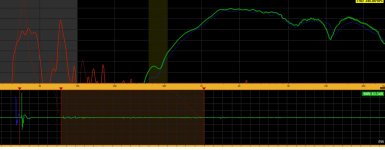
The blue curve is with the waveguide mounted directly onto the tweeter and the green curve is when I took off the front of the tweeter, before I mounted it on the waveguide, so that the dome came as far into the waveguide as possible - should have given me some less suckout....
Both measurements are gated, as can be seen in the impulse-window, where I cut it off just before the floor-bounce
Last edited:
Last edited:
I'm looking at it now, and I see a drive unit that in the 500Hz - 1KHz region you emphasise exhibits +/- 1dB variation in the on out to 60 degrees off axis responses, with no variation in the impedance response either, confirming the powertrain is acting as a pure piston across this BW. If it wasn't, you would see it there also.
Not at all like the M5a I think you'll find if you analyse the data. Unlike the M5a, which is clearly starting to run into issues from approximately 550Hz, which are visible in both the FR and impedance response (despite the lousy resolution), the HFC data for the SB shows it remains in piston operation, with its response curve and impedance both remaining linear out to approximately 4KHz, with minor variation as you move off-axis from about 2.6KHz due to diffraction from the roll surround (which is not cone or suspension resonance). The HiVi is a very inexpensive driver, and does not have anything like the same quality of cone, suspension, motor or basket design, and that is reflected in its inferior performance.
There is evidence of resonances in both drivers coinciding with the narrowing response.
I have read the usual statements about how metal cones are "pistonic" till break up. I bought the hivi. It is a one piece solid metal cone, a true piston. And guess what? It sounds metallic in the mids. I don't believe that this is a coincidence with the small ridges that are clearly seen in the FR. It actually produces incredibly dynamic bass, I will give it that.
Now a cheap hivi is not a seas excel. The seas uses mg which is light and self damping and expensive. Clearly they are trying to deal with resonances. If they were all "pistonic" then why bother? The seas is designed to control these resonances and presumably sounds much better through the mid. But is it pistonic till break up. No. Very close? Maybe. Better than the hivi. Naturally. Is it effectively transparent in the mids? Who knows. I don't own one.
Well, two points there. First, you haven't stated what you believe constitutes a 'normal dome', and second: any resonance is 'break up'. Degree of said is irrelevant: if it's resonance, that's what it is.
There are indeed, but if the drive unit is operating under pistonic conditions those are the product of cone & suspension geometry, not resonance.
They can be if the cone is resonating. If it isn't, they aren't. Simple as.
I don't want to oversimplify by saying its just the cone, as there are other parts like the former that are no doubt involved. But the cone is the main resonant structure.
Anyways if you want more solid evidence that metal cones exhibit resonances early on, and its not just people hearing with their eyes, there here it is.
The Use Of Beryllium In Transducers — VUE Audiotechnik
This was done with 100 mm domes which are obviously larger than tweeters but the whole area of the dome wasn't used. Notice that by 1khz there were resonances.
Last edited:
...All in WG148R and with Seas L15RLY.
Very interesting. I see some signs at c. 12KHz in these too, albeit variable, so possibly something in the profile. Still pretty good though.
Seas 27TFFC and raw
View attachment 835347 View attachment 835355
Alpine ring radiator
View attachment 835348
Morel DMS30s
View attachment 835354
All in WG148R and with Seas L15RLY.
That looks very good
I have the Morel Supreme lying around - maybe I should try that one. Why did you choose the Seas + WG and not the DXT, since they should cost the same?
And how did you mount the tweeters?
This waveguide gives me controled directivity a bit lower than DXT and i don't think that DXT could handle low crossover points that you see here. With separate waveguide i have controled directivity where i need it and i am not bound to just one tweeter (as you can see from above). I mounted it the same way you did. Alpine was glued with hot glue gun though, too small and no screw holes.
There are some pics HERE on mounting Morels.
Oh, and i liked Seas in this waveguide the least of three mentioned. Morel wins the day, then Alpine rr leaving Seas 27tffc on the last place which sounded quite bad - subjectively. No microdynamics and overdamped.
There are some pics HERE on mounting Morels.
Oh, and i liked Seas in this waveguide the least of three mentioned. Morel wins the day, then Alpine rr leaving Seas 27tffc on the last place which sounded quite bad - subjectively. No microdynamics and overdamped.
Last edited:
- Status
- This old topic is closed. If you want to reopen this topic, contact a moderator using the "Report Post" button.
- Home
- Loudspeakers
- Multi-Way
- Whoa, cool new tweeter from Peerless!!
